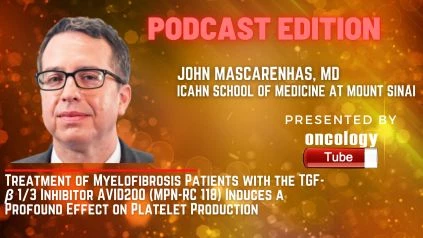Dr. John Mascarenhas is a member of The Tisch Cancer Institute and a professor of medicine at Mount Sinai’s Icahn School of Medicine. He is also the director of the Center of Excellence for Blood Cancers and Myeloid Disorders. He leads clinical research in the Myeloproliferative Disorders Program and directs the Adult Leukemia Program. Dr. Mascarenhas assesses rationale-based innovative therapeutics for patients with MPNs and AML as a clinical investigator in malignant hematology with a focus on translational research involving myeloproliferative neoplasms (MPNs) and their development to acute myeloid leukemia (AML). In this video Dr. Mascarenhas discusses the Oral ASH 142 presentation of phase 1b results of AVID200 in Myelofibrosis.
https://ash.confex.com/ash/2021/webprogram/Paper148995.html
TGF is important in the pathobiology of myelofibrosis (MF) since it not only promotes BMF but also increases the dormancy of normal but not MF hematopoietic stem cells (HSCs). TGF has also been shown to inhibit normal megakaryocyte (MK) production in the past (Bruno et al Blood 1998). TGF1 encourages normal human mesenchymal stromal cells to produce collagen (MSCs). MSC proliferation, SMAD2 phosphorylation, and collagen expression were all reduced when MSCs were treated with AVID200, a powerful TGF1/3 protein trap. In the absence of exogenous TGF, robust expression of pSMAD2 was detected in normal donor or MF-MKs. Addition of AVID200 to MKs lowered pSMAD2 without impacting total SMAD2/3 and increased the number of MKs. AVID200 treatment of MF MNCs resulted in an increase in the number of progenitor cells with wild type JAK2 and a decrease in mutant colonies.
A phase 1b trial of AVID200 (NCT03895112) was conducted and completed in INT-2/high risk MF patients who were resistant/intolerant to ruxolitinib (rux) and had a baseline platelet count of less than 25 x 109/L and grade 2/3 BMF. On Day 1 of a 21-day cycle, subjects received AVID200 intravenously. After 6 cycles of AVID200, the response was evaluated using IWG/ELN criteria. AVID200 was continued for subjects who received at least a CI or SD with a 1 grade decrease in BMF.
The results of the dose escalation trial (Mascarenhas ASH 2020) showed that AVID200 was well tolerated without dose-limiting toxicities at three dose levels (Lots A and B) in dose cohorts of 180 mg (A), 550 mg (A)/70 mg (B), and 180 mg (A)/70 mg (B) (B). At the two highest dosages tested (70 mg (B) and 180 mg (B), we present revised safety and efficacy results from the phase 1b dose expansion stage (B).
Nine subjects were treated with AVID200 in the dose escalation phase and 12 in the dose expansion phase [Table 1]. One subject withdrew before receiving treatment. The median period after stopping rux was 7.4 months (0.5-59.9). JAK2V617F (71%) was the most prevalent mutation found at baseline in this group, followed by TET2 (29%), ASXL1 (24%), and CALR (24%). (See Figure 1)
No DLTs were detected and Grade 3/4 AEs were observed in 16 (76.2 percent ) patients. Non-hematologic AEs of grade 3/4 were seen in 8 (38.1%) of the subjects, with one subject in each occurrence (epistaxis, mucositis, extraocular muscle paresis, fatigue, rash, duodenal hemorrhage, gastric hemorrhage, urinary tract infection, and syncope). Anemia (6; 28.3%) and thrombocytopenia (2; 14.3%) were the hematologic AEs of grade 3/4 [Table 2]. There were no fatalities reported.
The median number of cycles received was 5 (range 2–13), with 7 (33%) of patients receiving more than 6. According to central evaluation, a CI was achieved in one subject at dose level 2 [anemia, spleen, and TSS], five subjects had SD, three subjects had PD, and two individuals with 10% and 15% blasts at screening acquired MPN-BP while on study. Reasons for cessation by local PI were PD (n=8), lack of response (n=5), study completed (n=2), other (n=2), patient decision (n=1).
TSS change was -50 percent (-100 percent to +185.7 percent) and palpable spleen length change was +10 percent (range -70 percent to +150 percent). In seven evaluable participants, the median platelet count was 114 x 109/L at baseline (range: 28-695) and 215 x 109/L after cycle 6 (range: 66-263). (Fig 2A). During treatment, 17 participants showed a rise in platelets from baseline, and two subjects had their platelet counts normalized. Over all cycles, the maximum change in platelets from baseline was +63.8 percent [range -15.7 percent to +505.5 percent] (Fig 2B). There were no significant changes in BMF score or MK histo topography at the conclusion of treatment compared to baseline in paired bone marrow biopsy pathology samples for 12 participants eligible for central review.
TGF1 levels were raised in all patients, but not TGF2/3, as measured by ELISA, which were significantly reduced 21 days following the last dosage of AVID200.
The TGF1/3 protein trap AVID200 is well tolerated, although clinical responses in this advanced MF patient population were limited at cycle 7 of therapy, according to IWG/MRT response criteria. AVID200 therapy, on the other hand, resulted in a significant decrease in serum TGF levels and an increase in platelet counts, demonstrating that TGF1 plays a key role in MF-induced thrombocytopenia that can be reversed with AVID200 therapy. In thrombocytopenic MF patients, we believe that AVID200 is best used in combination therapy techniques.

